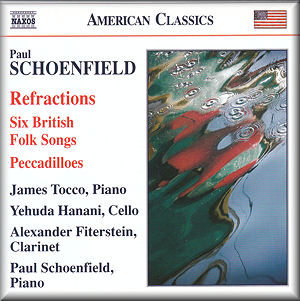 |
 |
|


alternatively
CD: MDT
AmazonUK
AmazonUS
Sound
Samples and Downloads |
Paul SCHOENFIELD (b.1947)
Six British Folk Songs (Jack Tar, The Basket of Eggs, The Gypsy Laddie, The Parting Kiss, The Lousy Tailor, A Dream of Napoleon) (1985) [22:11]
Peccadilloes (Allemagne, Fughetta, Rag, Waltz, Shuffle, Boogie) (1997) [16:10]
Refractions (Toccata, March, Intermezzo, Tarantella) (2006) [24:05]
 James Tocco (piano), Paul Schoenfield (piano), Yehuda Hanani (cello), Alexander Fiterstein (clarinet)
James Tocco (piano), Paul Schoenfield (piano), Yehuda Hanani (cello), Alexander Fiterstein (clarinet)
rec. March-May 2008, Oberlin Conservatory of Music, Oberlin, Ohio (Folk Songs, Peccadilloes); January 2008, Cincinnati Conservatory of Music, Cincinnati, Ohio (Refractions). DDD.
 NAXOS AMERICAN CLASSICS 8.559380 [62:26]
NAXOS AMERICAN CLASSICS 8.559380 [62:26] 
|
|
|
What does the innocent shopper read on the back of the disc
cover? Six British Folk Songs, a tribute to Jacqueline
du Pré … Each of the six Peccadilloes is to be enjoyed
as a guilty pleasure … Refractions are based on music
from Mozart’s The Marriage of Figaro. Sounds sweet, doesn’t
it? Songs, pleasures and Mozart. Think twice, O innocent shopper!
Under these pretty masks there be dragons! The music is tonal
– but sharp and untamed. It is intelligent – coming more from
the mind than from the heart – and also aimed at the
mind. Each movement is based on a germ – a motif, a rhythm,
a style – which is then vigorously developed, often to the point
of being unrecognisable. It is interesting to follow the flight
of the composer’s imagination – interesting, if not necessarily
fascinating.
In the Six British Folk Songs for cello and piano, the
piano part is played in turns by James Tocco and the composer
himself. Each pianist acquits himself excellently in this dense
and demanding score. The cello of Yehuda Hanani is deep and
luscious. It sings out beautifully every little note - yet can
be raw and rough when needed. This is wonderful cello playing
and it is beautifully recorded. The piano is recorded more distantly.
The lasting impression left by the music is somewhat heavy and
somber, even though it’s mostly in the major key. This mood
is lightened only in the last halves of The Parting Kiss
and of the Napoleon song, where the music is allowed
to be heartfelt and lyrical. Elsewhere, there is dark sarcasm
and quirky, choleric joy, reminiscent of Charles Ives.
In the insert note, Paul Schoenfield tells of his inspiration
for Peccadilloes. The name nods towards Rossini’s Sins
of Old Age. Each movement is based on a particular “bad
taste” motif, and “was inspired by and is enclothed within
an element of what is generally considered bad taste or inferior
culture”. The composer is not ashamed of it – on the contrary,
he invites us to share his “large chocolate sundae”, and appeals
to his fellow “serious musicians” not to be afraid of occasionally
being a bit more lightweight. The work is a tour de force
for a virtuoso pianist. It is impressive technically, if less
so musically. The transformations are skilled, but it comes
across more or less as a set of academic exercises. This has
nothing to do with the “bad taste” of the underlying motifs.
But, for such music, it is surprisingly lacking in surprises:
the first ten seconds of each part tell you what it will be,
and then the piece just goes on.
Refractions for cello, clarinet and piano are much, much
more Schoenfield than Mozart. Actually, the remaining similarity
to Mozart’s music is minimal: it’s like taking all the words
of a poem and rearranging them to create a new one. The lexicon
is vaguely recognizable – but it’s difficult even to prove the
origin. In the opening Toccata, Figaro is definitely
having a Chassidic wedding, with much ado about it. March
is the development of the rhythm of Non più andrai. Its
middle part occupies itself with “contorting and parodying music
from various recitatives”. This movement is dark and potent.
Intermezzo is a complete deconstruction of Dove sono
i bei momenti, a gloomy dirge leading us somewhere into
the black mists of the other side of life. The last two minutes
are gripping. The Tarantella is busy and noisy, without
a clear aim, but with some interesting moments. The four movements
fit well together, and form a defined chamber work, not a superficial
mosaic. It is indeed a valuable addition to the chamber repertoire,
and of all the music here it merits the label “American Classics”.
The cello of Yehuda Hanani is again the majestic centerpiece;
the other two instruments serve to accompany.
The music on this disc is sometimes extravagant, sometimes grotesque,
sometimes serious. I can’t say I was persuaded entirely: at
times it is frenetic without reason. However, I can definitely
imagine a mood that will call for exactly this type of music:
energetic, cerebral, with a mischievous grin. At some points
the music speaks of the archetype choleric temperament. The
first two works seem to me more academic fun, but the Refractions
are rewarding.
Oleg Ledeniov
|
|

